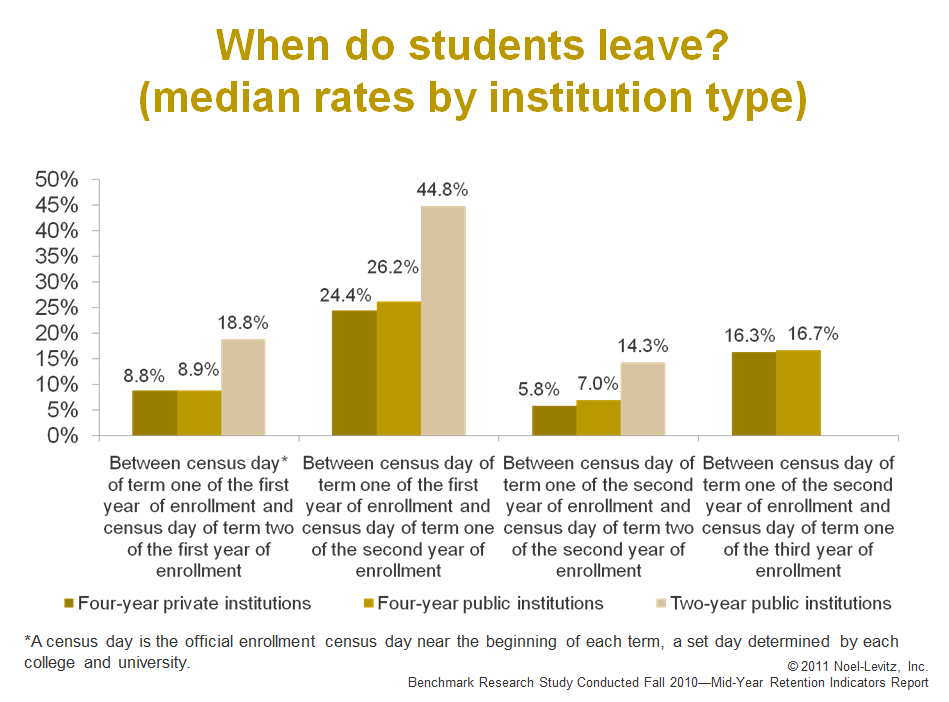student success
Strategies for strengthening second-year student retention during the summer months
On most campuses, we feel as if we’re sprinting down the home stretch to the lazy days of summer. However, in terms of year to year retention, we’re still mid-way through the race.
Noel-Levitz research shows that, for both first- and second-year cohorts, more students make the decision not to return during the spring and summer months than between the fall and spring terms. Thus there is a compelling reason for extra focus and emphasis this time of year and over the summer months.

Lew Sanborne, one of our Noel-Levitz retention consultants, works with his clients now, while the students are still enrolled, to make sure that continuing students are well positioned and confident for a smooth transition back to campus in the fall. Lew and his clients typically focus on the following areas.
Financing
In order to make sure students have the economic resources they need to stay enrolled, campuses:
- Make sure all students have filed their FAFSA so they can be packaged for financial aid.
- Encourage students to seek and apply for scholarships.
- Have students settle financial accounts with the college/university, including tuition, parking fines, library fines etc. This avoids financial holds that can deter registration.
Registration
This step identifies students who have not registered and their barrier to registration. As noted, financial holds are a common reason for non-registration. Helping students avoid financial holds can mean connecting students with the appropriate office and reviewing policies to be sure that only legitimate financial transgressions lead to a registration hold. (After all, if the student doesn’t return to campus, the odds of collecting that $10 parking fine are pretty slim.)
Housing
For traditional campuses and residential students, this involves cross-referencing registration lists with housing lists. Are there students who have secured housing who have not registered? Conversely, are there students who are registered who have not secured housing? Working with students now, in person, yields better results than via mail or phone over the summer, or when the pain of the absence of housing or classes is greater in the fall.
Staying connected with students over the summer
Implementing a continuing student communication flow with at least two touches over the summer months is a must. Campuses have told us that the summer is an ideal time to mobilize outreach to returning students because there are student workers available for calling campaigns. Given the intensive support students receive during their first year, they would be surprised not to hear from your campus once the school year ends. Reminding students about the value of an education from your institution and the success your graduates have achieved can reinforce students’ commitment to college and justify their financial investment.
Additional strategies for second-year students
Data from our national report The Attitudes of Second-Year College Students reveal that career issues (helping students identify work experiences or internships related to their major) and advising support to connect their major to a career (preparing a written academic plan for graduation to help students connect their major to a career) top the areas that students’ want to receive assistance with in their second year. Students would likely welcome a letter or e-mail highlighting the career services available on campus and online.
Similarly, students undecided about their majors or thinking about changing disciplines can be encouraged to use the summer months to further explore majors and careers. A reminder of the resources available to them would facilitate the exploration process and ease the anxiety associated with returning to campus in the fall.
Nearly three-quarters of the students in our research study indicated that they thought they would need to study more in their second year than they did during their first. Encouraging students to use the summer to arrange work schedules, child care services, and back-up plans can go a long way to supporting their need for more study time.
Students aren’t the only ones who can take advantage of the summer months for planning and exploration. It is also an ideal time for you and your team to prepare for fall programming by utilizing data from an assessment instrument such as the Second-Year Student Assessment™ (administered this spring to rising second year students). Knowing which academic, advising, career, financial, and personal support services students would like to receive help with allows you to design and strengthen your programming over the summer months. Being able to roll out programs the first few weeks of class in the fall, when students are more likely to participate, can boost the success of your programs and overall student success. Similarly, data at the individual student level can enhance advising relationships that may be shifting to a major advisor, or identifying students who intend to transfer to complete their degree.
Remember, while the summer may seem like a down time, it’s really a fertile period for preparation, planning, and persistence. Getting students off to a strong start is just as important when they return for their second year as when they arrive at campus for the first time.
What second-year strategies will work best at your campus? Please e-mail me if you would like to discuss these strategies in more detail. We are also hosting a free Webinar on retaining second-year students, featuring a presenters from two campuses who will share their second-year retention strategies.